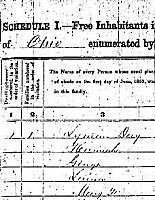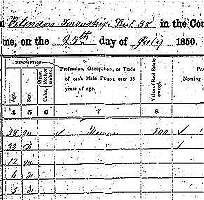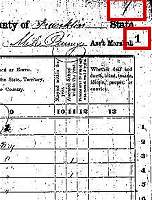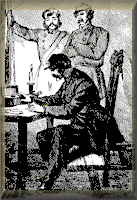USGenWeb Free Census Project Help, 1850 Census Help
Remember, please sign up with a State Census Coordinator before beginning a transcription.
The following following are available to our volunteer transcribers so that our file managers can convert them to the standardized text output to meet the goals of the project.
CENTRANS (MAC & PC) Centrans Instructions and Help
We have the following templates available for download:
Free Schedules:
MSExCel Spreadsheet |
MSWorks Spreadsheet |
Tab Text Templates
Mortality Schdules: MSExCel Spreadsheet | MSWorks Spreadsheet | Tab Text Templates
Slave Schdules: MSExCel Spreadsheet | MSWorks Spreadsheet | Tab Text Templates
[Note: These are zipped and are also available by request from Maggie Stewart. Please use "templates" as the subject of your email and include what year and type of template that you need.]
Header Information That's Needed:
 Part A |
 Part B |
 Part C |
- Census Year 1850
- Microfilm # (NARA Microfilm Series M432.) M432-679
- State Ohio (Click on Part A above)
- County Franklin (Click on Part C above)
- Subdistrict/Township Blendon Township Dist 38 (Click on Part B above)
- Enumerator Miles Pursey (Click on Part C above)
- Enumeration Date 25th day of July, 1850 (Click on Part B above)
- Transcriber - Your name here Maggie Stewart
- Proofreader - If proofread, put their name here. If you don't have one, put Not Proofread.
- Remarks (This is for something that refers to the entire page)
Columns present in the census: [Columns highlighted in red are additional columns that we require to be filled out unless otherwise noted.]
- Sheet # 1B (Fill in every line even if the enumerator didn't) - Sheet numbers are stamped in the upper right of each right hand page, beginning at 1 (Click on Part C Above) for each bound volume, going up one number for every two pages (1 sheet). Note that each volume begins with a right hand page, or 1B, there being no 1A. Also note that when you see the stamped sheet number it is ALWAYS on the B half of the sheet, the right hand page. This means that the other half, the A half, is the page filmed BEFORE the B half. In other words when you see sheet number 242 the page you are looking at is sheet 242B, the page before it is sheet 242A, the page after is sheet 243A. If you visualise the actual book the film was made from this concept is much easier to understand. We record the sheet numbers in the page number field of our transcription software, the page number in the reference field. For Example: You enter the following in the reference field 25th July, 1850; Miles Pursey; p.1 and when the formatting is done in text output it will read Enumerated on the 25th day of July, 1850 by Miles Pursey (Page 1) The exception to this is if you are using CenTrans where there are places for each of these items. In CenTrans, the sheet number needs to be entered (complete with the A or B) into the "Stamped Page No." field.
- Page # 1 (Click on Part A above) In CenTrans, the page number needs to be entered into the "Page No." field on the upper right part of the header.
- Line # (These run 1-42 per page. The Enumerator's were very inventive and sometimes these are not all filled in or you will find a line of entries underneath or above the printed forms.)
- Dwelling (1) Houses numbered in order of visitation (Fill in every line even if the enumerator didn't)
- Families (2) numbered in order of visitation (Fill in every line even if the enumerator didn't)
- The Name (3) of every Person whose usual place of abode on the first day of June, 1850, was in this family. (This column gets placed in two separate places when transcribed.)
- Last Name (3)
- Do not put all in capitals
- Fill in every line even if the enumerator didn't
- First Name (3)
- Age. (4)
- Sex. (5)
- Color (6) White, black, or mulatto.
- Profession (7), Occupation or Trade of each Male Person over 15 years of age. (If ditto marks are present fill in the "value" they represent for each ditto mark.)
- Value (8) of Real Estate owned.
- Place of Birth (9). Naming the State, Territory or Country. (If ditto marks are present fill in the "value" they represent for each ditto mark.)
- Married (10) within the year.
- Attended School (11) within the year.
- Persons over 20 (12) years of age who cannot read & write.
- Whether (13) deaf and dumb, blind, insane, idiotic, pauper, or convict. (If there is something written out in this column, place a capital "X" in the column and write the word in the remarks column.)
- Transcriber's Remarks (Fill this out only if some additional comment is needed.)
Special Notes/Comments:
- Example of online
completed 1850 census transcription. (This output was done using the CART
software.)
- States with surviving 1850 census schedules:
- Alabama
- Arkansas
- California
- Connecticut
- Delaware
- District of Columbia
- Florida
- Georgia
- Illinois
- Indiana
- Iowa
- Kentucky
- Louisiana
- Maine
- Maryland
- Massachusetts
- Michigan
- Minnesota Territory
- Mississippi
- Missouri
- New Hampshire
- New Jersey
- New Mexico Territory
- New York
- North Carolina
- Ohio
- Oregon Territory
- Pennsylvania
- Rhode Island
- South Carolina
- Tennessee
- Texas
- Utah Territory (1851)
- Vermont
- Virginia
- Wisconsin


